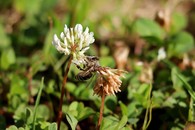|
Thank you for subscribing to this newsletter. This is a place for us to update you on what we are doing at South Hams District Council and what things are going on around the District. It will tell you what's going on nationally and things you, our residents and businesses, can be doing to reduce your carbon footprint and manage your land to improve the environment and its biodiversity.
If you have anything you would like to include in this newsletter then contact our Climate Change Specialist by email here and follow us on Twitter and Facebook.
Get Involved

Share Shed
Ever thought about borrowing rather than buying? Well, the Share Shed is a mobile library of practical things. Based in Devon, it offers over 350 items to be borrowed, including:
- Tools
- Household appliances
- Camping and gardening equipment
- Sewing machines
- Suitcases
- and much more
Totnes (on Thursdays)
Market Square, Totnes, TQ9 5SF opening times: Thursdays - 1 p.m. to 5 p.m.
South Brent (on Fridays)
Old School Community Centre, Totnes Road, South Brent, TQ10 9BP opening times: Fridays from10 a.m. to 12 p.m.
Ashburton (on Fridays)
St Andrew’s Church Car Park, West Street, Ashburton, TQ13 7DT opening times: Fridays from 1 p.m. to 3.30 p.m.
Buckfastleigh (on Saturdays)
Stop 1
Buckfastleigh Rangers Football & Social Club, 3 Duckspond Rd, Buckfastleigh, TQ11 0NL opening times: Saturdays from 10 a.m. - 11.30 a.m.
Stop 2
Victoria Woodholme Car Park, Plymouth Rd, Buckfastleigh, TQ11 0BD opening times Saturday from 12pm to 1.30pm
To find out more, click here.
|

No Mow May
When it comes to everyone's gardens, small changes can make a big difference. Research estimates that UK gardens combined amount to a land area of 432,924 ha, roughly five times the size of South Hams in total.
When it comes to providing vital nectar and pollen for bees, butterflies and other insects, every flower counts, and your lawn can help provide that feast.
Plantlife’s #NoMowMay campaign doesn’t ask you to do much. In fact, it asks you to not do anything at all…
Just lock up your lawnmower in May and let the wild flowers in your lawn bloom, providing a feast of nectar for our hungry pollinators.
To find out more and take part, click here.
|

Spotlight on Sustainable Staverton and their 'Pledge for Nature'
Sustainable Staverton have recently launched 'My Pledge for Nature'.
Biodiversity decline is taking place all around us, but together we can make a difference by pledging a project in your own garden or land, large or small. Participants can select from a number of measure, such as installing a bird box to planting a wildflower patch or planting a tree.
This scheme is up and running in Staverton and the group are happy to share the project with other parish groups in South Hams by contacting Simon Oldridge by email at simon.oldridge@sus-sh.org.
To find out more about this click here.
|

The Woodland recently published a report, a first of its kind, laying out the facts and trends on the current state of the UK's native woods and trees.
Here is a summary of their key findings and priority actions.
Key Findings
1. Woodland cover is gradually increasing, but woodland wildlife is decreasing
2. Woods and trees are vital for a healthy, happy society
3. Woods and trees are subject to a barrage of coinciding threats
4. Not nearly enough is being done
Priority actions
1. Expand woodland tree cover
2. Enhance and protect existing woods and trees
3. Improve the evidence
4. Invest in the future
To read more click here.
|

Researchers from Natural England have developed a picture of the impact that different UK habitats can have in taking carbon out of the atmosphere and helping us hit net zero by 2050, whilst delivering for both biodiversity and conservation.
The study looked at a wide range of the UK’s natural habitats, finding that:
- Woodlands have high rates of carbon sequestration – depending on the species, age and location. New native woodlands can support biodiversity at the same time as taking up carbon. Old woodlands can become substantial carbon stores, with a hectare of native woodland sequestering the equivalent CO2 each year as flying London to Rome 13 times.
- Saltmarshes can be highly effective carbon stores, as well as helping coasts adapt to future climate change. Restoration of sea grass meadows also has potential to capture carbon from the atmosphere in its vegetation, and also trap carbon from elsewhere in sediments. One hectare of saltmarsh each year buries the carbon equivalent of an average car’s annual carbon emissions.
- Orchards and hedgerows are effective at storing significant amounts of carbon but generally cover a smaller area than other habitats and are cut regularly, limiting the amount of carbon gain. Their sensitive management, however, can increase carbon storage whilst providing benefits for wildlife and the cultural heritage in farmed landscapes.
- Peatlands are the largest carbon stores. When in a healthy condition they soak up carbon slowly but can go on doing so indefinitely. Peatland soils can be over 10 metres deep, holding huge carbon stocks that have developed over many millennia. Carbon held in the deep peat soils of fens and raised bogs hold eight times as much carbon as the equivalent area of tropical rainforest.
- Heathlands and grasslands store more carbon than modern agricultural landscapes but less than peatlands, saltmarsh and old woodlands. Protecting these old, established habitats is important for biodiversity, as well the carbon stocks they hold, as both may have taken centuries to accumulate.
To read more click here.
|

In December 2020, the Climate Change Committee reported its recommendations under the Sixth Carbon Budget, among this was a recommendation to slash emissions by 78% by 2035.This has now been accepted by the Government.
Also, for the first time, the UK’s sixth Carbon Budget will incorporate the UK’s share of international aviation and shipping emissions. Moving forward, the cross-government Net Zero Strategy will also be published ahead of COP26, with Business Secretary Kwasi Kwarteng currently commissioning work across Whitehall to help inform the ambitious plans across key sectors of the economy.
To read more, click here.
|

Natural England's latest research report is all about carbon storage. The natural environment can play an important role in tackling climate change, but the destruction of it is one of the first casualties of climate change.
Restoring natural systems can start to reverse this damage at the same time as supporting and enhancing biodiversity, alongside delivering co-benefits for climate change adaptation, soil health, water management and society
In this report, they:
• Review the available evidence and summarise the carbon storage and sequestration rates of different semi-natural habitats with an indication of the range of values and the degree of confidence we can place in them.
• Facilitate the comparison of carbon storage and sequestration rates between semi-natural habitats.
• Apply evidence to England. the main focus has been on evidence gathered on British ecosystems, but we have also included studies from other regions, particularly north west Europe, where they are relevant and helpful.
• Identify key evidence gaps in order to highlight where there is need for future research to support land use and land management decisions for carbon.
• Provide those working in land management, conservation and policy with relevant information required to underpin decisions relating carbon in semi-natural habitats.
To read more click here.
|
|